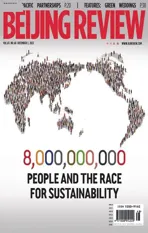What Lies Beneath
2022-12-06RuinshelpunravelthemysteriesofearlyChinesecivilizationByTaoZihui
Ruins help unravel the mysteries of early Chinese civilization By Tao Zihui
The year was 2018. With its turquoise scales and golden eyes,hundreds of pieces scattered everywhere, a broken dragon slowly arose from the soil in Henan Province. The fantastical creature dated back over 3,000 years, all the way to the Shang Dynasty(1600-1046 B.C.).
Archaeologist and scholar with the Chinese Academy of Social Sciences(CASS) Tang Jigen took fragments of the discovery to a hospital in Shenzhen,Guangdong Province, because he wanted to do a CT scan of the dragon in a bid to uncover its secrets.
But in the face of antiquity, modern technology stood in vain. The turquoise material proved radiation resistant.Tang, then captain of the Yin Ruins Archaeological Team, had to find another way to obtain the desired information.
“Through archaeological discoveries,we can learn more about where we came from, how our basic necessities, language and written word are related to our ancestors, and what kind of civilizations have sprouted from the land underneath our feet,” Chen Nan, a professor at the Academy of Arts and Design at Tsinghua University, toldBeijing Review.
In the eyes of those looking in from the outside, archaeology is a rather romantic subject, conjuring up movie-like images of adventurous imperial tomb excavations and explorations. But in the eyes of archaeologists, the discipline is one involving much disappointment and exasperation: Once ancient objects were buried in the ground, they were buried by time. Archaeologists are constantly looking for answers, but they keep encountering new questions.

An aerial photo of Yinxu, or the Yin Ruins, the ruins of the capital of the Shang Dynasty (1600-1046 B.C.), in Anyang City, Henan Province
But whenever their motivation lies in ruins, there’s always one spot that can restore their faith. This particular site’s first excavation is considered the symbolic birth of Chinese archaeology. Furthermore, it is the site with the longest continuous excavation time, the best-cleaned remains and the widest assortment of unearthed cultural relics in all of China.
Welcome to Yinxu, or the Yin Ruins—Yin being the Shang Dynasty’s capital city.
“In terms of archaeology, no site is more important than the Yin Ruins,”Li Boqian, a professor at the School of Archaeology and Museology at Peking University, once said.
Exposed and exhilarating
Yinxu became the first imperial center to be documented and subsequently substantiated by archaeological findings.Before this, scholars disagreed over the dynasty’s factual existence.
Only 100 years ago, people’s knowledge about the Shang Dynasty was still confined to theShi Ji, orThe Records of the Grand Historian, a monumental history of ancient China compiled by the revered scholar Sima Qian of the Western Han Dynasty (202 B.C.-A.D. 8).
But in October 1928, Dong Zuobin(1895-1963), an archaeologist who specialized in Shang oracle bone inscriptions, wielded a shovel into the earth at Xiaotun Village near Anyang City in the north of Henan. And made history.
The discovery at Xiaotun not only catapulted the village to fame but also marked the most important archaeological finding in 20th-century China and went on to be listed as a UNESCO World Heritage Site in 2006.
What’s more, after the site was confirmed to have been that of the Shang’s capital, the complex of ruins became best known for its large discovery of oracle bone scripts, marking the identification of the earliest-known Chinese written words.
Samples of history
The Oracle Bone Pit, also called the YH127 Oracle Bones Cellar, was discovered in June 1936, during the 13th excavation of Yinxu. The shape of this cellar is a regular shape with 10,000 oracle bones, which is of rich significance both in history and study.
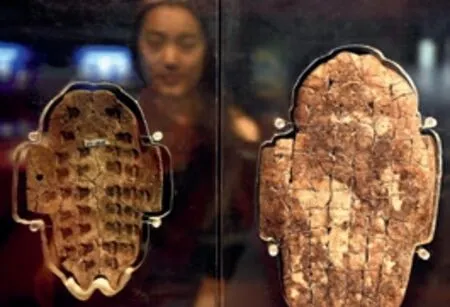
A visitor takes a closer look at shells and bones, once used in divination rituals during the Shang Dynasty, at the Yinxu Museum on October 12, 2018
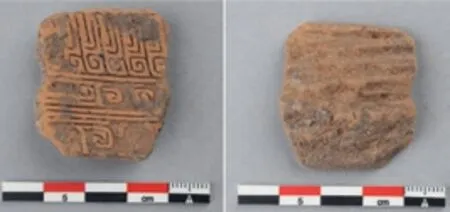
The front and back of a mold once used to cast bronze. The artifact was unearthed from a bronze casting workshop in the Yin Ruins
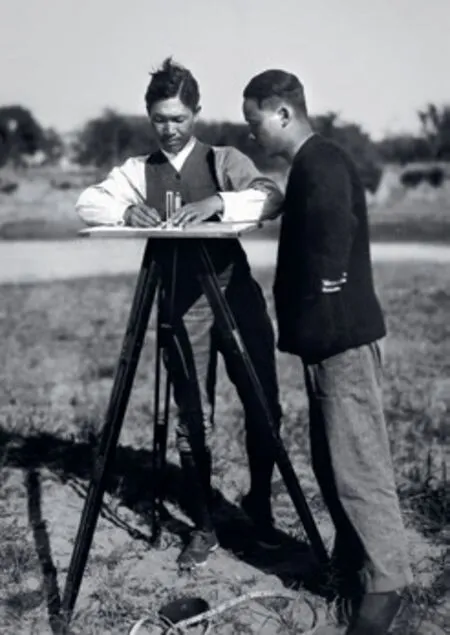
Archaeologists Dong Zuobin (right) and Li Chunyu work at the first excavation of the Yin Ruins in 1928
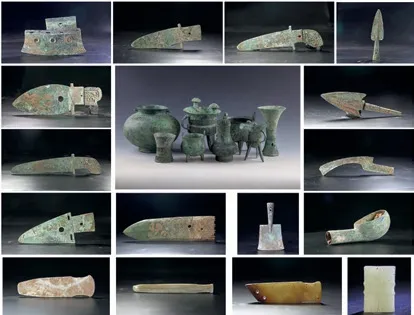
Artifacts unearthed from the Taojiaying site at the Yin Ruins. The excavation of the southwestern part of this site led to the discovery of a huge assortment of bronze and pottery tools in 2021
Prior to Dong’s 1928 discovery,these shells and bones were believed to belonggu(dragon bones). Whether or not the following story is true, one thing is certain: Bones like these became popular in the 1800s for their purported healing powers. One day in 1899, Wang Yirong, a famous scholar of ancient scriptures, noticed a bone fragment in his herbal medicine materials that had some interesting scribbles on it. Upon careful inspection, Wang suspected that the markings were an archaic hieroglyphic inscription, probably older than the thenoldest form of Chinese writing found on bronze vessels from the Western Zhou Dynasty (1046-771 B.C.). He was right.It was the earliest writing ever found in East Asia.
“After 1928, the interpretations of the inscriptions on tortoise shells and bones,believed to be the earliest Chinese characters, gradually started to paint a picture of what Chinese society was like more than 3,000 years ago,” Chen said.
The Yinxu excavation findings have been matched with the inscriptions to gain a more detailed representation of the Shang Dynasty, archaeologists currently working at the site announced at a news conference organized by the National Administration of Cultural Heritage in Beijing on November 10.
Xu Lianggao, a researcher with the Institute of Archaeology under the CASS,said the information helped confirm the location of key buildings and structures.
In an area where palaces and ancestral temples were believed to once have proudly stood, new findings indicate a 60,000-square-meter royal resort, including a lake with a central island, manmade waterways flowing into the nearby Huanhe River and more architectural foundations.
“We were able to update our previous understanding of the layout of Yinxu’s palaces,” Xu said. “Images of the Shang civilization are now becoming more vivid and complete.”
Archaeologists at the ruins also uncovered a road dating back over 3,000 years, offering new insights into archaeological studies of the UNESCO World Heritage Site.
The east-west road, which has been excavated across a length of 80 meters so far, stretches 14 meters in width at its widest point.
It is paved with pebbles, bones and broken pottery pieces of similar sizes,with several rut marks visible on the road’s surface.
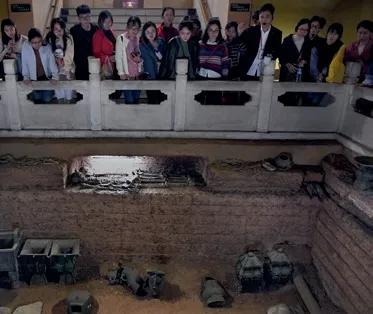
Tourists visit the tomb of Fu Hao at the Yin Ruins on October 14, 2018. The tomb of Fu Hao, a talented female general and the queen of King Wuding of the Shang Dynasty,is the only tomb of a member of the Shang royal family to have remained intact
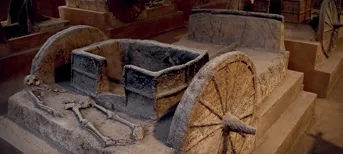
Tourists visit the chariot pit at the palace area of the Yin Ruins, in Anyang, Henan Province,on October 14, 2018
The newly discovered road runs parallel to a previously unearthed one.At 500 meters apart, both intersect with yet another previously unearthed northsouth avenue, forming a block-like urban structure with remnants of densely distributed residences, tombs and handicraft workshops on both sides.
Like Tang said in 2019, “Yinxu is like a small universe in archaeological studies.There are just too many mysteries. When you’ve solved one, the next one appears.” BR
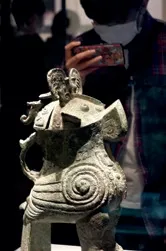
A visitor captures an owl-shaped zun,dating back over 3,000 years, on display at the Henan Museum in Henan Province on September 24, 2020. A zun is a type of ceremonial bronze wine vessel used by Shang aristocrats. This owl-shaped zun was excavated in 1976 at the tomb of Fu Hao

Chen Nan, a professor at the Academy of Fine Arts at Tsinghua University,displays the oracle emojis he designed on September 24, 2019. Having worked on oracle bone script designs since 1999,Chen has been bringing the pictographs back to life through emojis and different spin-off products
